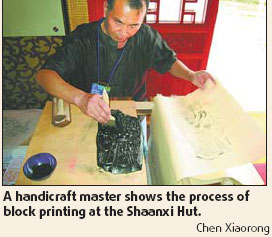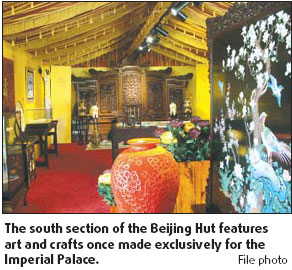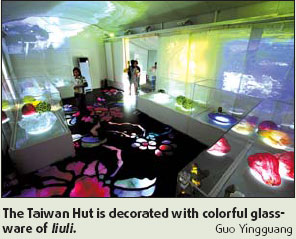Proud to call this home
|
Shadow play masters stage a show for visitors. Chen Xiaorong |
Thirty white huts dot the east side of the Olympic Center District in a bid to showcase China's rich and diverse traditional culture.
The exhibition entitled China Stories aims to promote intangible Chinese culture and heritage, including folk customs, dance, music and handicrafts from nearly all of the country's 30 provinces.
The huts, referred to as xiangyun (auspicious cloud), are sectioned off into corners representing different provinces and autonomous regions in China. Organized by The Ministry of Culture and the Beijing Organizing Committee, the exhibition, which opened to the public on Augusts 8, will last until the end of the Paralympics.
Noted celebrities such as Jackie Chan, who is a huge fan of Chinese culture, paid a visit to the exhibition and recorded a theme song for the event called China Witness. China Daily brings you the first series of articles featuring a look inside the various xiangyun huts.
Shaanxi Hut

At the Shaanxi House in the Olympic Park, many of the provincial traditions are on display for tourists. The house features Shaanxi's renowned paper-making invention and puppet play art.
"By using real objects, multimedia audio-visual art and combining interaction with audience, (the hut) strives to show the beauty and uniqueness of Shaanxi's traditional culture," says Sa Xiaohu, an official from the culture department of the province who is helping manage the hut.
Sixty-nine-year-old peasant Zhang Fengxue skillfully uses a knife to cut out parts of a special tree needed to make paper - displaying the ancient process of the Chinese invention.
Various tools and devices used in the paper-making process including a stone sink, paper-lifting sift, steamer, pestle and mortar, are on display for visitors.
Two senior villagers from Beizhang village in Shaanxi province, renowned for its paper-making tradition, show visitors their ancient technique.
As the capital of 13 dynasties, Xi'an, the provincial capital of Shaanxi, is the cradle of Chinese civilization. Paper-making, one of the top four great ancient Chinese inventions, came into being in the Chinese West Han Dynasty (BC206-25AD).
Today, traces of the technique still can be found in Beizhang village. Since the Qing Dynasty (1644-1911), paper produced from the village was made exclusively for official use. The paper is very soft and elastic-like. It is made from mulberry, which grows in abundance around the village. Visitors are invited to rub and stretch the newly produced paper.
Nearby, behind a white cloth-screen in the Shaanxi House, the province's shadow play master Liu Yingzhe and his partner are busy manipulating two shadow play puppets.
They are performing a play called Vendor which tells the story of a man who was engaged under the decision of his parents. He is restrained from seeing his fianc before the wedding ceremony due to tradition, so he dresses up as a female vendor to spy on his soon-to-be wife.
Originating from the Han Dynasty (BC206-220AD), Shaanxi's shadow play has rich content, profundity in cultural connotation with peculiar sculpt and masterly carving.
In the Yuan Dynasty (1206-1368), Shaanxi's shadow play had developed into its peak period. It was not only popularized in folk but also developed into recreation activities in the army. From that time onwards, Shaanxi's shadow play grew in popularity across the entire country.
Beijing Hut

The Beijing Hut offers a mix of folk and royal crafts.
Chief Beijing hut designer Liu Xiaoning admits it was a bit of challenge finding a balance between the two art forms.
"As the capital, which gathers thousands of artisans in Chinese history, Beijing boasts a veritable laboratory of craftsmanship, from arts and crafts once made exclusively for the Imperial Palace to fascinating folk handicrafts made for ordinary people," says Liu. "I have to present both for visitors."
Entering the south section of the hut is like stepping into a king's study. A huge redwood antique table lies in the upper east area with a golden throne and delicately carved wooden screen in the backdrop. Amid the display are two inlaid gold lacquer wares in the shape of white cranes, which symbolize immortals in Chinese mythology.
Atop the large wooden table is a cloisonn enamel (a squiggly-shaped ornament), carved with patterns and inlaid with precious gems.
The object was once a common Chinese household item. But, in the Qing Dynasty, it became a pure ornamental called ruyi (as you wish), which was often bestowed by the emperor upon his ministers or subjects.
Visitors can write down on paper their wishes for the Olympic Games in Chinese calligraphy-style by using the brushes and ink slabs left on the table.
Two magnificent dragon robes also hang on the wall, reflecting the unique embroidery skill of the Qing Dynasty. Other exquisite pieces made by art masters adorn the area including a palace carpet, filigree and inlay ornaments and jade-carved sculptures.
Lacquer carving vase made by Wen Qingang, silk figurines made by Hua Shulin and cloisonn lions made by Zhang Tonglu, all feasted the visitors' eyes.
The western area of the hut allows visitors to watch how the widely popular kongzhu, a spool-shaped toy, is made. The popular folk game is often played by Beijing residents in the mornings.
"I am so honored to show the process of making this spool-shaped toy and how the buzzing sound is made when it maneuvers," says Zhang Guoliang, a master renowned for making delicate kongzhuespecially double-domed versions.
The hut also has a station that showcases watercolor block printing, a unique technique, used for reproducing famous Chinese paintings and calligraphy.
Sichuan Hut
Chinese music fills the air with lovely melodies as Li Quyang plays the qiang flute, blowing into the instrument for more than five minutes without exhaling.
The student from quake-hit Beichuan Middle School demonstrates the unique respiration skills needed to play the ancient Qiang minority folk instrument inside the Sichuan Hut.
The 20-year-old Qiang minority Olympic volunteer came to the Chinese capital from his home in Sichuan province to promote his home and culture at the Games.
The ancient reed flute is widely used by Qiang musicians to convey messages of love and nostalgia.
"Only few masters can blow into the flute incessantly for over 30 minutes nowadays, which impels me to inherit it," says Li.
The Qiang ethnic group is one of the earliest members of the great multi-ethnic family of China. As China's only ethnic Qiang autonomous county, Beichuan is home to a large number of ancient cultural relics. But sadly, Qiang's cultural heritage suffered incalculable losses when the May 12 earthquake struck the area.
"The embroidery pieces and stoups you see here are all borrowed from National Culture Palace," says Gao Zeyou, the curator of the Beichuan Folk Culture Museum. "All the 800 pieces of Qiang antiques and folk crafts preserved in our museum are buried under the rubble as the whole building collapsed in the earthquake."
More than 30,000 people of Qiang origin were killed in the devastating quake, including many folk artists.
"Qiang is a group which has language, but no characters. As long as its people exist, its culture can be passed down," says Gao.
Dozens of pictures depicting Qiang's architectures, costume, religious belief, festivals and folk arts plaster the wall. In the corner, middle-aged Yang Dequan sits quietly making shu embroidery (one of the four celebrated Chinese embroideries). The peony pattern under her hand is vivid with precise lines and shining colors.
Sichuan boasts many intangible culture heritages. It is also renowned for its rich folk culture and high passion for preservation its endangered art.
Taiwan Hut

An impressive collection of glassware made of liuli, or colored glaze, awes visitors inside the Taiwan Hut.
Delicate pieces in marvelous shapes and patterns lie on the white table for display. They range from transparent to opaque and colorless to multicolored.
Beside a showcase, Loretta Hui-Shan Yang, a successful film star and multiple Best Actress winner of the Golden Horse Award of Taiwan, shares her interest in the art with visitors.
"Twenty years ago, I was impressed by several pieces of liuli artworks in France and was curious about the pate-de-verre (technique for making liuli)," Yang recalls.
Taken by the beauty of the art, the actress, who is fond of Chinese history and culture, abandoned her successful career to enter the unfamiliar world of liuli with a team of seven others.
She was surprised to hear from a Japanese liuli scholar that China's earliest liuli artifact, made using the pate-de-verre method, was a pair of ear cups found next to the famed jade clothes in Emperor Liu Sheng's tomb dating back to China's Western Han Dynasty (BC202-8AD). After archaeological confirmation the glass material was of Chinese origin - and the technology was indigenous to China - Yang and her team attempted to revive the artistry embedded in their ancestry. Liuli is now one of Taiwan's most representative art forms.
"Imbued with history and tradition - and combining artistic, aesthetic and creative design, liuli has raised the cultural bar," says Taiwanese visitor Chen Yan. "More and more people including young generation like this art."
The floor of the hut is equally astonishing. Several peonies made mainly from liuli spread across the surface, displaying the extraordinary beauty of the magical glaze.
Several photographs of ordinary Taiwanese taken by the region's famous photographer Shen Xinlin line the walls near the hut's exit, capturing everyday life of the Taiwanese people.
(China Daily 08/16/2008 page15)















